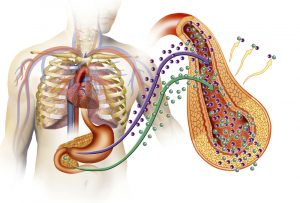A University of Saskatchewan (USask) research team’s discovery of the additional health benefits of an appetite-suppressing protein has doubled the potential for scientists to find new ways to treat obesity and metabolic disorders in animals and humans. The researchers’ findings, recently published in the journal Nature Communications Biology, highlight their discovery of the lipid-lowering effects of nesfatin-1-like peptide (NLP). This newly identified peptide – or small protein – is a close relative of nesfatin-1 (NESF-1), which regulates food intake and body weight.
Nesfatin-1 is a peptide secreted by peripheral tissues and the central and peripheral nervous system. It is involved in the regulation of energy homeostasis in connection with the regulation of food and water intake. Nesfatin-1 can cross the blood-brain barrier in both directions. It suppresses food intake independently of the leptin signaling pathway and increases insulin secretion from pancreatic beta-islet cells. For this reason, nesfatin-1 has attracted attention as a new therapeutic agent, particularly for the treatment of obesity and diabetes mellitus.
New Therapies for Many Metabolic Diseases

The scientists led by Dr. Suraj Unniappan (PhD), a member of the research team and professor at the Western College of Veterinary Medicine (WCVM) and holder of the Centennial Enhancement Chair in Comparative Endocrinology, have found that both NESF-1 and NLP reduce lipid (fat) accumulation in human liver cells. The joint study involved researchers from WCVM and the USask College of Medicine. Although the lipid-lowering effect of nesfatin-1 has been previously reported, Unniappan explained that the identification of NLP and the understanding of its lipid-lowering capabilities in human cells represent new advances in the field of endocrinology.
However, the researchers are still a long way from translating these findings into practice, but now have additional multiple targets available that could be investigated for the treatment of lipid disorders and therapeutic advances. The research team’s discovery is hopeful news given the lack of new therapies for many metabolic diseases – including non-alcoholic fatty liver disease (recently renamed metabolic dysfunction-associated steatotic liver disease or MAFLD). A hormone-based drug was approved in the United States in March 2024, but so far there are no drugs exclusively for the treatment of this disease.
Specific Protein Lowers Lipid Levels
Typical treatment plans for people and animals suffering from metabolic disease usually consist of dietary changes and exercise to gradually lower body weight and reduce fat accumulation. Unniappan and his research team are at the forefront of nesfatin-1 research. Discovered in 2006 by a Japanese research group, nesfatin-1 was initially known for its ability to suppress food intake.
The USask team went a step further than previous studies and successfully demonstrated that the genetic disruption of NLP leads to changes in genes involved in fat metabolism in mice. They found that disruption of the gene that is the source of this protein [NLP], which occurs naturally in these animals, actually leads to changes in genes related to fat metabolism. The discovery of such results – that administering NLP lowers lipid levels, while disrupting its production alters lipid metabolism – underscores its central role in metabolic regulation.
Unniappan and Dr. Atefeh Nasri (PhD), who completed her doctoral program at USask in 2023 and is now a postdoctoral fellow at Dalhousie University, collaborated with Dr. Scott Widenmaier (PhD), an assistant professor of anatomy, physiology and pharmacology and metabolic disease expert at the USask College of Medicine. The fourth member of the team was graduate student Mateh Kowaluk.
Unniappan hopes that this new research can pave the way for further research into treatment options. He plans to work with his collaborators to expand this research to more complex animal models – including rodents – and eventually to study larger animals such as cats and dogs. Like humans, these species also suffer from obesity and associated metabolic disorders.







